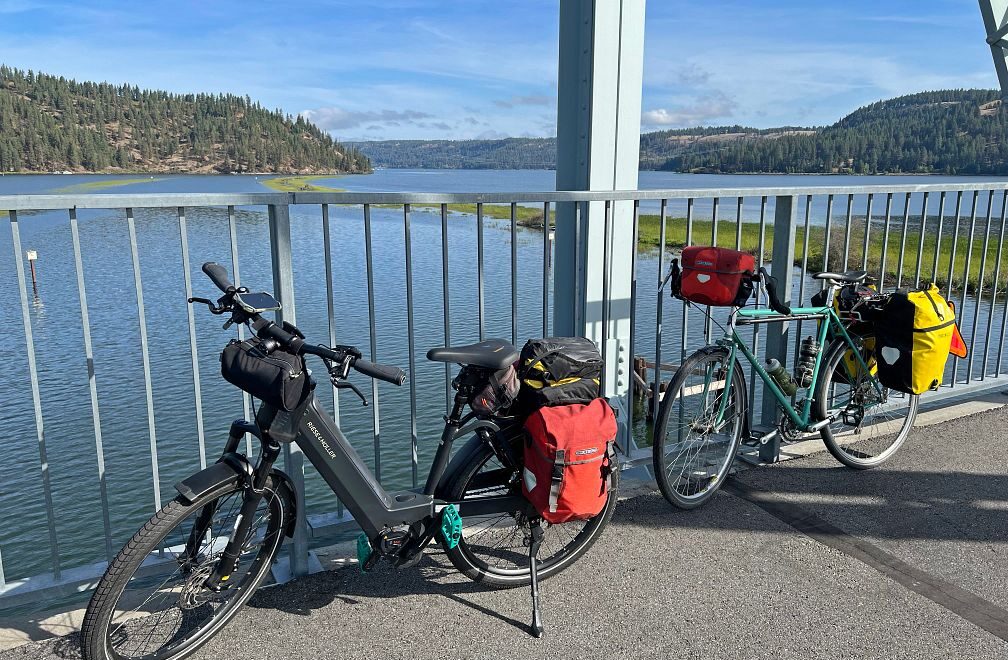After working at Adventure Cycling for more than three decades, Teri Maloughney knew her way around a bike. However, as the years went by, the act of cycling wasn’t as fun as it’d once been. And although there were still traditionalist naysayers who pooh-poohed the idea of e-bikes as “real” biking, Teri says that, at a certain point, she simply didn’t care anymore. She wanted to enjoy her bike again.
“It brought back the joy of riding for me again — it really did,” Teri said. “Having worked at Adventure Cycling for all those years, I’ve ridden a lot of miles, but it was getting so that it wasn’t fun, and it certainly wasn’t fun to commute. And then all of a sudden it was like, ‘Oh, this is fun again.’”
So, what’s the secret to unlocking fun on an e-bike? We turned to Teri, along with industry experts Jill Nazeer, Salsa’s Brand Marketing Manager, and Noel Kegel, Adventure Cycling board member and president of Wheel & Sprocket, for their share of tips.
Tip 1: Invest in Quality, Especially If You’re Planning for Distance
As of this writing, e-bikes are more affordable than they’ve ever been. And while that’s great in some respects — because access matters, and anything that gets more riders on bikes can’t be all bad — there are some caveats.
As Noel says, a less expensive e-bike might get you moving. How long it’ll last — and how long it’ll take to get fixed should things go south — however, is another matter.
“I own a bike shop, and we see lots and lots of e-bikes that are pure garbage that we literally can’t fix,” he says. “There’s no 1-800 number to call, there’s no way to get parts. Sometimes we try to diagnose the problem, but from a product-quality perspective, they’re impossible to work on, you know? And so people buy, like, disposable e-bikes, essentially.”
In that respect, it’s not so different from any bike. Because, Noel says, you could very well ride a Walmart bike clear across the country. But the last thing you want to do is spend all your time fretting over if, when, and how long you’ll need to pull off for a fix.
“You want gear that supports your trip,” he says, “not gear that becomes the trip.”
Your best approach for avoiding headaches? Consider going with an e-bike from an established brand that makes e-bike components, because those are the parts most neighborhood bike shops with a knack for e-bikes are going to stock.

Tip 2: Know Where You’re Riding
When you first start shopping for an e-bike, you’ll have questions. Among the first that you’ll want to consider, however, is where you’re riding. In part because the answer will help inform what style of bike you opt for — gravel? mountain? road? — but also what your local roads, rail trails, and bike paths will allow.
Jill suggests every rider should learn their e-bike’s classification. (Note: More than three-quarters of U.S. states now recognize the three-class e-bike system, but you’ll want to familiarize yourself with your own state’s laws and the laws of any states you’ll be riding through. People For Bikes offers one-page PDF summaries for each state here.)
Class 1: Pedal assist only. Maximum assisted speed of 20 mph. Legal on most roads, trails, and paths but not in all states.
Class 2: Throttle-assisted, which means that the motor can assist if you’re not pedaling. Maximum speed of 20 mph. Legal on most roads, trails, and paths but not in all states.
Class 3: Pedal assist up to 28 mph. Legal on roads and bike-only lanes, but not allowed on most bike paths (including MTB trails) or multi-use paths.
“Beyond that,” Jill says, “it’s the exact same conversation as any bike: How big of a tire do you need? Do you need suspension? Flat bar? Drop bar? All that kind of stuff.”
To be sure, there are still some other aspects to consider as a consumer. Knowing that you’ll likely need e-bike-specific panniers, for example, or a heavier-duty car rack to accommodate the e-bike’s heftier weight is certainly important. Noel says you’ll also want to consider how certain brands have different placement of the motor. (He prefers mid-drive motors, which are located in the bottom bracket, rather than hub motors, which are located in the rear hub, because they allow the bike to ride “very naturally.”)
Above all, Jill says, the most important thing is that you’re doing your research ahead of time: Because the technology is advancing at such a brisk clip, there are regular updates to what’s on the market, ranging from more efficient batteries, “walk” modes and brief boosts of turbo, software updates that increase a battery’s watt hours, to say nothing of the now sleekly designed bikes themselves.
Tip 3: Know Your Bike, Know Yourself
When it comes to planning, the differences between e-bike and non-e-bike touring are minor (though changing a tire on an e-bike presents a much heftier obstacle). Still, much in the same way that you need to know your body’s limitations — how far you can go in one stretch, how much weight you’re able to manage, etc. — you also need to be aware of your e-bike’s limitations.
“If you’re actually going to do long-distance touring, you know, be sure that you’ve done the weekend shakedown,” Teri says. Make sure that you know how much battery you go through in a range of settings — whether that’s uphills or gusty headwinds — particularly if you’re tapping into the bike’s boost function. And if you’re planning to load the bike down with camping gear, a cookstove, and all the rest, make sure you know what it feels like to have that weight on your bike and how it affects your battery usage.
“As with any kind of riding, the most important thing to me is that you are prepared for what you’re going to encounter,” Teri says. “But with an e-bike, you want to know how much charge you have because that is going to determine the length of your day.”
Which, in turn, gets at one of the biggest differences between touring and e-touring.
Tip 4: Think About Where You’ll Charge — And Don’t Forget to Do So
Make charging part of your route planning. “Look for lunch or second breakfast stops with outdoor plugs,” Teri says. Bike shops, cafés, or even campgrounds with electric hookups can be good bets. And at night, bring your battery inside your tent if it’s cold. Lithium batteries don’t love freezing temps.
“The most important thing that you have to remember is, did you charge it?” Teri says.
This might seem obvious, but in some respects it’s a paradigm shift, especially for those riders who’ve honed habits and routines over the course of decades.
“A lot of times, you finish for the day, and you’re like, I am done. I want to go take a shower, I want a snack or whatever,” Teri says, noting that if you neglect to charge your battery, you’ll be paying for it the next day. “It’s a mindset. You really have to be aware that if you’ve used it for a period of time, you charge it.”
Tip 5: Have a Plan B
Here, “B” stands for “Backup” and “Battery.”
A few years back, Teri and her sister joined an Adventure Cycling tour that passed through South Dakota’s hill country. As the name suggests, it was hilly. “Like, super hilly,” Teri says. However, despite riding the same route, Teri says that she and her sister had very different experiences.
“I did not have a backup battery, and my sister did,” she says. “Having that backup battery meant that she didn’t pay attention like I did. I had to be doing calculus, and I had to be paying attention, and she didn’t, because she had a backup.”
In fact, on their longest day — a 54-mile ride with lots of hills — Teri says that she was at 1 percent when she finally made it back to camp that night, despite charging during lunch. Her sister, on the other hand, had tapped into her backup battery but hadn’t had to fret over her charge. Adventure Cycling Guided Tours staff recommend bringing two batteries on any ebike-friendly tour.
Certainly, there’s no harm in toting along an extra battery; though depending on the size, it might add between 10 and 20 pounds. Jill says that, in recent years, several of the major manufacturers, like Bosch, have been addressing “range anxiety” with range extenders.
“It’s basically like the size of a water bottle, so it’s super easy to incorporate that into the storage on your bike,” Jill says. “It’s not going to fully charge it, but it’s like an extra little bit to get you going a little longer.”
Summing It Up
Whether you’re touring or bikepacking overnight or dreaming of a coast-to-coast adventure, an e-bike can make the journey more accessible and enjoyable. But as with all great rides, preparation matters. Learn your bike. Know your range. Know your terrain. Ride in “Eco” mode whenever possible. And always — always — charge your battery.
The post E-Bike Touring and Bikepacking Tips appeared first on Adventure Cycling Association.



